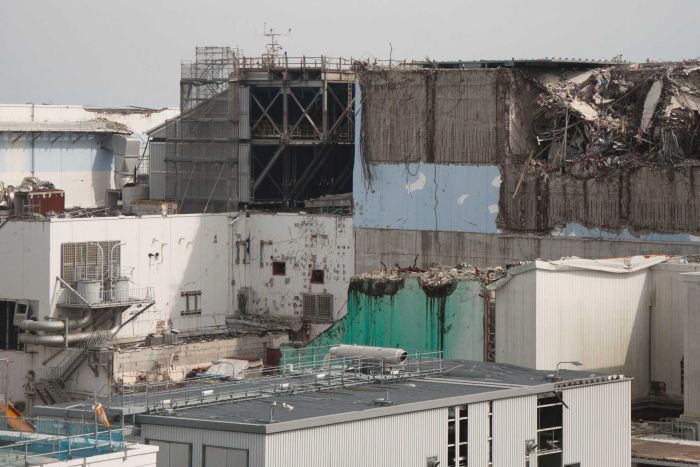
FUKUSHIMA CLEAN-UP CHIEF STILL HUNTING FOR 600 TONNES OF MELTED RADIOACTIVE FUEL
Mark Willacy
The operator of the stricken Fukushima nuclear plant has revealed that 600 tonnes of reactor fuel melted during the disaster, and that the exact location of the highly radioactive blobs remains a mystery.
Key points:
- 600 tonnes of nuclear fuel still needs to be accounted for
- Robots sent into the reactor have been disabled by radiation
- 10 million bags of contaminated soil have been removed
In an exclusive interview with Foreign Correspondent, the Tokyo Electric Power Company's chief of decommissioning at Fukushima, Naohiro Masuda, said the company hoped to pinpoint the position of the fuel and begin removing it from 2021.
But he admitted the technology needed to remove the fuel has to be invented.
"Once we can find out the condition of the melted fuel and identify its location, I believe we can develop the necessary tools to retrieve it," Mr Masuda said.
"So it's important to find it as soon as possible."
Clean-up to take decades, cost tens of billions of dollars
Reactors 1, 2 and 3 at the Fukushima Dai-ichi nuclear plant suffered catastrophic meltdowns in the hours and days after a giant tsunami swamped the facility on 11 March, 2011.
Thousands of workers are braving elevated radiation levels to stabilise and decommission the plant.
Media player: "Space" to play, "M" to mute, "left" and "right" to seek.
TEPCO says the process will take 30 to 40 years and tens of billions of dollars.
"In Reactor 1, all of the fuel has melted down from inside the pressure vessel," Mr Masuda said.
"In reactors 2 and 3, about 30 per cent to 50 per cent remains in the pressure vessel and the rest has melted down. But unfortunately, we don't know exactly where [the fuel] is."
The head of the United States Nuclear Regulatory Commission (NRC) at the time of the meltdowns at Fukushima doubts the fuel can be retrieved, saying such an operation has never been done before.
"Nobody really knows where the fuel is at this point and this fuel is still very radioactive and will be for a long time," said Gregory Jaczko in an interview with Foreign Correspondent in Washington.
"It may be possible that we're never able to remove the fuel. You may just have to wind up leaving it there and somehow entomb it as it is."
Radiation killing search robots inside reactor
For the first time, TEPCO has revealed just how much of the mostly uranium fuel melted down after the tsunami swamped the plant.
"It's estimated that approximately 200 tonnes of debris lies within each unit," said TEPCO's Naohiro Masuda.
"So in total, about 600 tonnes of melted debris fuel and a mixture of concrete and other metals are likely to be there."
TEPCO has attempted to use custom-built robots to access high-dose radiation parts of the reactor buildings where humans cannot go.
"All the robots have been disabled, the instrumentation, the camera … have been disabled because of the high radiation fields," former NRC boss Gregory Jaczko said.
Appointed to head the US nuclear watchdog by President Barack Obama in 2009, Dr Jaczko resigned a year after the Fukushima disaster.
A particle physicist, he now questions the safety of nuclear power.
"You have to now accept that in all nuclear power plants, wherever they are in the world … that you can have this kind of a very catastrophic accident and you can release a significant amount of radiation and have a decade long clean-up effort on your hands," he said.
10 million bags of contaminated soil in gigantic waste dumps
Another supporter turned opponent of nuclear power is Naoto Kan, who was the Japanese prime minister at the time of the Fukushima meltdowns.
He says those who argue that nuclear power is a safe, cheap source of energy are misguided.
"So far, the government is paying $70 billion to support TEPCO," Mr Kan said.
"But that is not enough. It will probably cost more than $240 billion. I think 40 years [to decommission the plant] is an optimistic view."
More than 100,000 Japanese are still unable to return home because their communities lie in elevated radiation zones.
Some people have returned to their towns and villages since the completion of decontamination work, which often involves the removal of up to 15 centimetres of topsoil from fields and from around homes.
More than 10 million large bags of contaminated soil and waste have so far been collected. The bags are now stored in thousands of sites around Fukushima, with some of the piles several storeys high.
"In order for people to come back, we need to show that the Fukushima plant is in a stable condition," Naohiro Masuda said.
"We need to make that the situation … we're working on something [for] which there is no textbook."
Watch Foreign Correspondent: Into the Zone.
VIEW ANOTHER VIDEO

